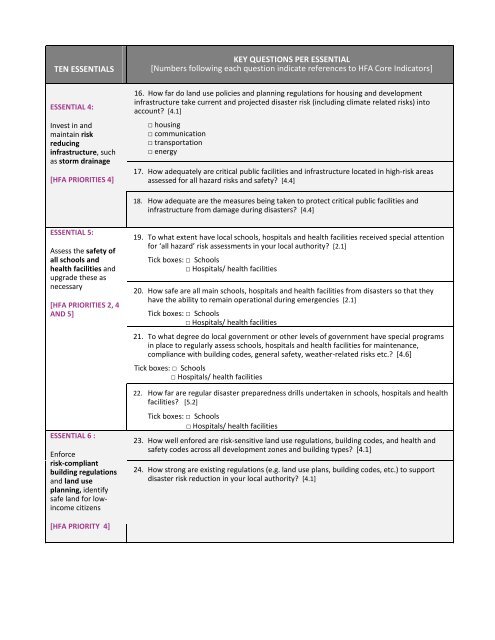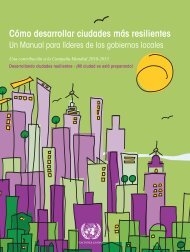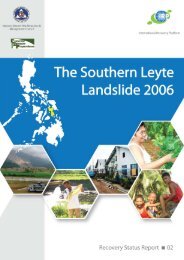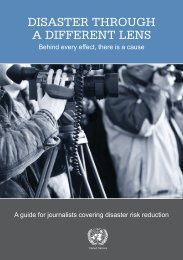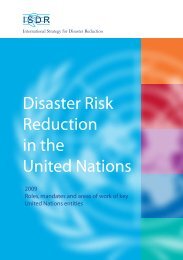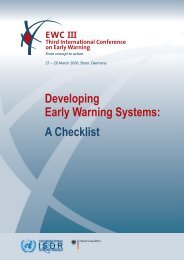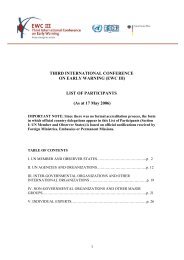Overview of Local Government Self-Assessment Tool (LGSAT
Overview of Local Government Self-Assessment Tool (LGSAT
Overview of Local Government Self-Assessment Tool (LGSAT
You also want an ePaper? Increase the reach of your titles
YUMPU automatically turns print PDFs into web optimized ePapers that Google loves.
TEN ESSENTIALS<br />
ESSENTIAL 4:<br />
Invest in and<br />
maintain risk<br />
reducing<br />
infrastructure, such<br />
as storm drainage<br />
[HFA PRIORITIES 4]<br />
ESSENTIAL 5:<br />
Assess the safety <strong>of</strong><br />
all schools and<br />
health facilities and<br />
upgrade these as<br />
necessary<br />
[HFA PRIORITIES 2, 4<br />
AND 5]<br />
ESSENTIAL 6 :<br />
Enforce<br />
risk-compliant<br />
building regulations<br />
and land use<br />
planning, identify<br />
safe land for lowincome<br />
citizens<br />
[HFA PRIORITY 4]<br />
KEY QUESTIONS PER ESSENTIAL<br />
[Numbers following each question indicate references to HFA Core Indicators]<br />
16. How far do land use policies and planning regulations for housing and development<br />
infrastructure take current and projected disaster risk (including climate related risks) into<br />
account? [4.1]<br />
□ housing<br />
□ communication<br />
□ transportation<br />
□ energy<br />
17. How adequately are critical public facilities and infrastructure located in high-risk areas<br />
assessed for all hazard risks and safety? [4.4]<br />
18. How adequate are the measures being taken to protect critical public facilities and<br />
infrastructure from damage during disasters? [4.4]<br />
19. To what extent have local schools, hospitals and health facilities received special attention<br />
for ‘all hazard’ risk assessments in your local authority? [2.1]<br />
Tick boxes: □ Schools<br />
□ Hospitals/ health facilities<br />
20. How safe are all main schools, hospitals and health facilities from disasters so that they<br />
have the ability to remain operational during emergencies [2.1]<br />
Tick boxes: □ Schools<br />
□ Hospitals/ health facilities<br />
21. To what degree do local government or other levels <strong>of</strong> government have special programs<br />
in place to regularly assess schools, hospitals and health facilities for maintenance,<br />
compliance with building codes, general safety, weather-related risks etc.? [4.6]<br />
Tick boxes: □ Schools<br />
□ Hospitals/ health facilities<br />
22. How far are regular disaster preparedness drills undertaken in schools, hospitals and health<br />
facilities? [5.2]<br />
Tick boxes: □ Schools<br />
□ Hospitals/ health facilities<br />
23. How well enfored are risk-sensitive land use regulations, building codes, and health and<br />
safety codes across all development zones and building types? [4.1]<br />
24. How strong are existing regulations (e.g. land use plans, building codes, etc.) to support<br />
disaster risk reduction in your local authority? [4.1]


